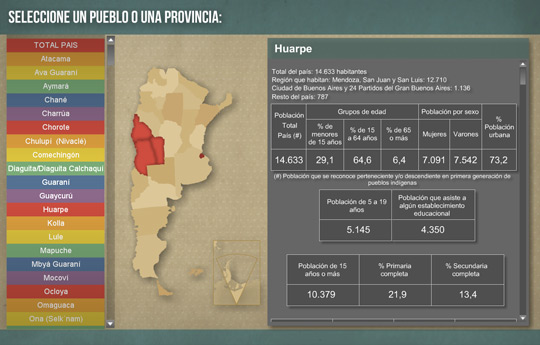Science for education
A CONICET researcher participated in the elaboration of the Atlas of Indigenous Peoples
The web site, under the Ministry of Education, gives access to the different native communities of Argentina.
Census data, description of the places they inhabit, myths, customs and research on the communities conducted by prestigious scientists are part of the information the Atlas provides.
Sebastián Valverde, CONICET assistant researcher at the Social Anthropology Area of the Anthropological Sciences Institute (UBA-CONICET), affirms that “this work articulates research with transference through a didactic format. We developed different materials for the communities and for the promotion of their problems”.
The Atlas comprises 3 maps:
1_Of Ethnic Identity, where the user can locate the different communities and display their distribution in the national territory.
2_Interactive for the territorial location of the indigenous peoples, where users can consult information about the population, education and language according to the Supplementary National Population, Household and Housing Census of 2001 and the Supplementary Survey on Indigenous Peoples (ECPI) 2004-2005.
3_Of the Conquest of the Desert, with the analysis of the different expeditions carried out by the governments between the years 1779 and 1883 to the territories inhabited by the native populations.
Valverde, who has studied different communities for more than a decade, particularly the Mapuche people, affirms that through academic information the map helps to break down stereotypes and stigmas on indigenous peoples.
“There is a clear tendency to regard indigenous peoples as past inhabitants, as if they were savages who lived far from society. The process to develop this change is slow, but we are moving towards that direction”, the researcher explains.
For Valerde, in order to collect data, different anthropological and historical techniques were complemented such as Ethnography, the compilation and the work with documents and interviews in the territory to community leaders.
“With our work we try to build, rise and uphold the native identity of the peoples”, the anthropologist affirms.
The map: a road towards education
Daniel Sticotti, coordinator of the Educational Map Programme of the Ministry of Education, explains that the project started in 2003 as a geographic information system for the education sector of Argentina. Later on, the programme was expanded so as to allow other organizations and institutions have their own maps.
As regards the Atlas of Indigenous Peoples, Sticotti states that from an educational point of view, this programme provides teachers with educational tools and students and researchers with the information they may require. “It is a window on communities historically disregarded. At this moment, we are working on six new maps to go on contributing to knowledge”, he says.
For Valverde, investigations and academic contributions on native peoples developed by institutions such as CONICET, different Universities or by the Ministry of Education, for instance, are very important because they work as endorsements and legitimize the knowledge and wisdom of those communities.
The anthropologist Laura Ruggiero works on the content generation of the Atlas and she comments that this project was designed to provide schools with university knowledge because, Laura considers, that a large part of the material for schools are marked by stigmatizing and stereotyped gazes on indigenous peoples.
“Many times, the illustrations of student’s books do not have any reference, as if everything that appeared in them would fit all peoples in general. They show indigenous peoples dressed with lainclothes and they are fixed in a distant time in the past. That is the reason why it is important to highlight the characteristics of each of these peoples and the complex processes they went through, and still are, when they seek for the compliance of their rights”, the anthropologist concludes.
For more information about the Educational Map Programme http://www.mapaeducativo.edu.ar/
Atlas of Indigenous Peoples: http://www.mapaeducativo.edu.ar/pueblos_indigenas/
- By Alejandro Cannizzaro
- About investigation
- Sebastián Valverde. Assistant researcher. UBA-CONICET.
- Daniel Sticotti. Coordinator of the Educational Map Programme. Ministry of Education
- Laura Ruggiero. Ministry of Education.
